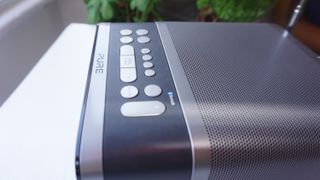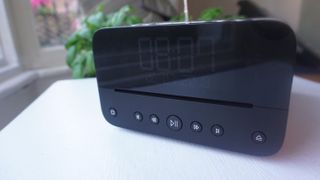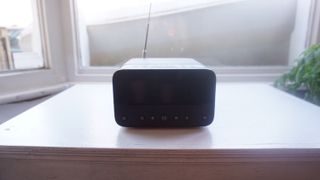TechRadar Verdict
Oozing functionality, Pure’s all-in-one music system is perfect for a multigenerational household, but some may find the interface needlessly difficult to use.
Pros
- +
Premium, solid build
- +
Hugely versatile
Cons
- -
Far too many buttons
- -
Unintuitive control system
Why you can trust TechRadar
With so many speakers, media players, and domestic gadgets on the market, furnishing your home with all the devices you need can feel like a herculean task. And how many gadgets does anyone really have shelf space or plug sockets for?
Enter Pure’s all-in-one music system, the Siesta Home.
Pure’s speciality as an electronics company is in digital radio. It’s Siesta Home range is designed to offer a quality DAB+ and FM radio player that can also play your CDs, stream music over Bluetooth from your laptop or phone, and even function as an alarm clock or kitchen timer.
It certainly promises to be useful, and we sat down with the Siesta Home to see exactly how well it delivers for its £199/€249 price tag.
Design

The Siesta Home looks as smart and modern as anything we’d expect to come from Pure’s design team. At 107 x 172 x 202mm (WxHxD) it’s a little chunkier than your average radio/alarm clock, but compact enough to fit on a bedside table.
The rear two-thirds of the body are taken up by the metal speaker grille, while the front third is finished in Graphite (gray) or Polar (white) with a metal trim and an array of buttons on the top.
The front face is host to Pure’s wonderfully clear CrystalVue+ screen, with a smooth glass surface and auto-dimming LED display that turns down the brightness when you’ve got sunshine streaming in. This is also where you’ll find the unobtrusive CD slot, wedged between the display and another row of buttons for controlling music playback or skipping between radio stations.
The display is clear and uncluttered. Most of the space is dedicated to displaying the time and music source, with smaller icons for set alarms and volume.
Round the back are a pair of USB ports for charging and connecting peripherals, while a 3.5mm headphone jack will allow you to listen to the radio in peace with any wired headphones.
The array of buttons on the top of the device is where things get a bit confusing. There are the expected buttons for snoozing, setting timers, or changing the source between Bluetooth, CD, FM and Digital Radio. One very welcome addition is an EQ button that enables you to adjust the prominence of particular frequencies depending on the room you’re in. You’re going to get a lot more sound absorption in your carpeted living room than in a kitchen full of hard, reflective surfaces, for example.

But the majority of the navigation is done via a left/right menu system that sees you moving through countless menus trying to find the appropriate options. And as the majority of the display is given over to the clock face, the act of moving between different panes one by one in the remaining space feels restrictive – especially given the sheer number of functions you’re expected to navigate.
While some complexity of interface is to be expected with an all-in-one device like this, it’s still slightly daunting to interact with – and the remote doesn’t help matters by replicating the entire set of buttons found on the speaker, and even adding a few of its own.
The result is an experience that will be slightly frustrating for those used to more intuitive interfaces or voice assistants, while likely proving daunting for less tech-savvy members of the family.
Performance

Aside from the above concerns over the interface, the Siesta Home delivers on its promises.
The size of the buttons ensures that you know what you’re pressing, with enough backlighting to help in low light. The alarm and timer features are also well thought out, with four distinct slots for different alarms, a kitchen timer for time-sensitive cooking, and a sleep timer that puts the Siesta Home into standby mode after a set amount of time to avoid keeping you awake at night.
When it came to testing the audio performance it was relatively easy to connect and stream via Bluetooth, and the benefits of the speaker’s generous size became apparent when playing Gorillaz’ Humility.
The 3-inch wide-range speaker was fully capable of bringing out the pumping rhythm of the drum machine on the bass end, aided by two passive radiators on either side to stabilize the movement of the woofer and add noticeable depth to the lower end of the audio.
While something like the Amazon Echo beats it for sheer volume, with a 15W output compared to the Siesta Home’s 10W, the latter’s higher-quality drivers ensures a richer, fuller sound, as you’d hope for the price.
The audio is less impressive than you’d enjoy from a dedicated music speaker for a similar price, but it’s quite sufficient for what’s required day-to-day from a DAB radio and Bluetooth speaker.
Verdict

The Pure Siesta Home offers a huge amount of functionality for a single piece of kit, and its timer and alarm features make it ideal to serve as a smartly-placed speaker in the bedroom or kitchen.
We’re unsure, though, how many people would actually make use of all of the Siesta Home’s options and features, unless it’s being used in a household whose occupants enjoy a variety of listening styles and audio formats.
If you’re choosing a device mainly for the audio experience, or want to have an eye-pleasing radio on your windowsill, the Pure Evoke range is a much more focused blend of style and performance, without the separate alarm features of the Siesta home.
But if you want a single, multi-purpose device that can wake you up in the morning, and keep you entertained with music or radio chatter throughout the day – all without making your old CD collection redundant – then the Siesta Home may be the device for you.
Henry is a freelance technology journalist, and former News & Features Editor for TechRadar, where he specialized in home entertainment gadgets such as TVs, projectors, soundbars, and smart speakers. Other bylines include Edge, T3, iMore, GamesRadar, NBC News, Healthline, and The Times.

Is there a moral imperative for businesses to share data?

Why sovereign AI infrastructure is driving worldwide adoption of Generative AI

Real life 6G speed tests revealed by Japanese tech giants — 100Gb/s transmissions could become the norm for mainstream wireless network data transfer within a few years

